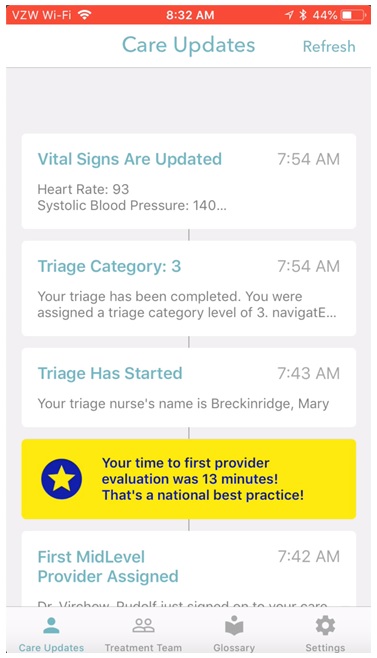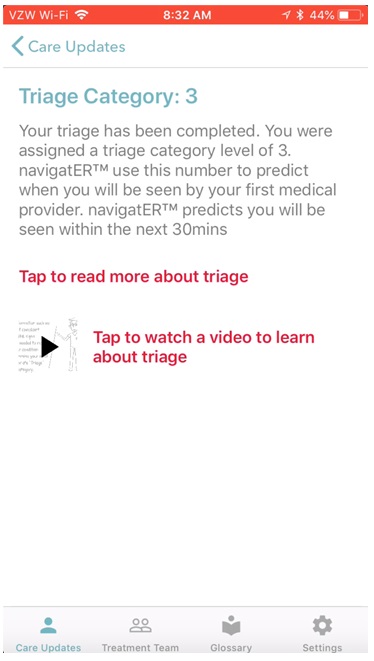Innovations to enhance efficiency, patient communication and code outcomes.
During ACEP18, AngelMD highlighted several medical innovations at the InnovatED area of the Exhibit Hall. While the last edition of More Disruption Please focused on medical devices, this edition focuses on four digital health innovations. UBQ increases ED efficiency, NavigatER enhances patient communication, HealthPals assists clinical decision making and RevivePro improves both the quality and record keeping of codes.
UBQ: Increasing ED Efficiency
 UBQ, the winner of the Digital Health cohort at ACEP18, focuses on increasing the efficiency of the ED. Their goal is to replace the traditional ESI triage system with resource alignment, patient assignment and predictive analytics. UBQ’s software provides an operating system to direct care in the ED that incorporates data science, queuing theory and predictive AI models. Their platform is cloud-based and can either integrate with the Electronic Health Record (EHR) or work as stand-alone software.
UBQ, the winner of the Digital Health cohort at ACEP18, focuses on increasing the efficiency of the ED. Their goal is to replace the traditional ESI triage system with resource alignment, patient assignment and predictive analytics. UBQ’s software provides an operating system to direct care in the ED that incorporates data science, queuing theory and predictive AI models. Their platform is cloud-based and can either integrate with the Electronic Health Record (EHR) or work as stand-alone software.
Pilot programs in Virginia EDs resulted in decreased variability of “door to doc time,” length of stay and the number of patients who left without being seen. In a California pilot, UBQ reduced the length of stay by an hour for higher acuity patients and by half an hour for lower acuity patients. Emergency Physicians also felt like the workload was more equitable and predictable, and this increased job satisfaction. Learn more about UBQ at http://ubq.webflow.io/
NavigatER: Enhancing Patient Communication
NavigatER increases patient satisfaction by providing patients with status updates and educational content. The goal of this mobile platform is to “activate” patients receiving care in acute care settings by engaging them throughout the care process. Their software addresses gaps in communication by providing patients with app-based updates in “real-time” during their emergency department visit. For example, when an elderly patient has an injury, NavigatER alerts the patients when X-rays have been ordered and then provides them with educational content on what an X-ray is, why it would be ordered and how long it is expected to take before the results ready.
All of this is performed without adding additional tasks to the Emergency Physician. The software also addresses patient satisfaction during the ED visit by assessing the patient experience during various phases of care (triage, workup, treatment, and discharge) and then targeting patients with intelligent app-based interventions. To learn more about NavigatER, check out their website at www.navigater.io
HealthPals: Assisting Clinical Decisions
 HealthPals was created to improve the clinical decision process and ensure that care provided in an ED is both evidence-based and in accordance with professional guidelines. Currently, according to a RAND study, 50% of clinical decisions are suboptimal and HealthPals was created to increase the quality of care provided in our EDs. HealthPals uses the CLinical INTellignece (CLINT) engine to store either standard or customized treatment pathways.
HealthPals was created to improve the clinical decision process and ensure that care provided in an ED is both evidence-based and in accordance with professional guidelines. Currently, according to a RAND study, 50% of clinical decisions are suboptimal and HealthPals was created to increase the quality of care provided in our EDs. HealthPals uses the CLinical INTellignece (CLINT) engine to store either standard or customized treatment pathways.
CLINT can either integrate with your EHR (as a tab in EPIC, for example), or function as standalone software. The fist image below shows how CLINT can be used to address changeable contributions to an individual patient’s cardiovascular risk score (QRISK2). The second evaluates medication needs for different populations of diabetic patients. To learn more about HealthPals, visit their website at www.healthpalsinc.com
RevivePro: Improving Quality and Documentation of Codes

RevivePro is a resuscitation improvement system that was developed by Format Health in partnership with the University of Washington Medical Center’s Code Blue Team to improve real-time management, documentation, and debriefing of codes. RevivePro software includes a reference to the American Heart Association (AHA) guidelines, the ability to capture images of the rhythm strip in real time, a timer and a medicine dosing calculator. RevivePro provides an all-in-one system to augment team memory of ACLS protocols, laminated cards, manual calculators and a wall clock.
By using the software, the code team also creates a record of the code that can be used for the patient’s chart, post-code evaluation, and for any legal defense purposes. The platform also includes “CodeBlueIQ” — an online portal that includes discrete data elements from all captured codes to enable QI teams to review past codes, evaluate performance against AHA guidelines, and set goals for future codes. Format Health created RevivePro after legal cases illustrated that not only were current charting practices incomplete, but could also be legally indefensible. As one of five vendors certified by the AHA, RevivePro also interacts with the AHA’s Get With The Guidelines registry to help improve resuscitation science. To learn more about RevivePro by Format Health, visit their website at www.FormatHealth.com





